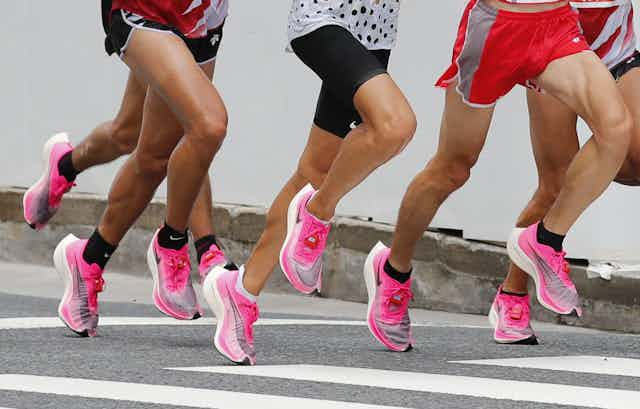In the 1960s, when traditional cinder athletics tracks were replaced by spongy, synthetic surfaces, endurance running experienced a revolution. Long distance runners began clocking far faster times on the synthetic tracks, smashing multiple world records in the process.
Today, another revolution is afoot: the development of the so-called “super shoe”, which is driving another spike of record toppling in endurance running. The new shoe technology was introduced to road running in 2016 and track running in 2019, and since those key dates virtually all endurance running world records, from the 5,000m to the marathon, have been broken.
This has divided opinion in the athletics world, with some arguing the shoes are unfair while others argue they’re just like synthetic running tracks: an inevitable technological leap for endurance runners to capitalise upon.
Research in sports biomechanics helps explain exactly what’s happening inside these shoes. While super shoes are clearly disruptive to old records – some of which have stood for decades – this technology should simply be seen as another entry in sports’ long list of performance-enhancing innovations.
Nike’s new shoes
In the 2016 Olympic marathon, all three male medallists climbed onto the podium in the same shoes. They were a Nike prototype, later released as the “Nike Vaporfly 4%”, which are now almost ubiquitous on the feet of elite road runners.
Then, in 2019, similar super-shoe technology hit the athletics track. A slew of Nike-sponsored athletes, wearing Nike’s prototype track spikes, began running some astonishingly fast times.
The performance enhancement afforded by both types of super-shoe – the trainer and the track spike – is generated by enhancing athletes’ running economy, which means reducing the energetic cost of running at a given speed.
The original Vaporfly improved the running economy of highly trained runners by around 4% when compared to a control marathon shoe – hence the 4% moniker. In practice, this equates to a rough improvement in running performance of between 2% and 3%.

The shoes have delivered on this claim. In the years since the 2016 advent of the Vaporfly, the times of the top 50 male marathon runners have improved by about 2% on average. For the top 50 female marathon runners, that figure was closer to 2.6%. Nike’s track spikes are considered to be delivering significant running economy boosts to athletes, too.
Fancy footwork
Several footwear features are behind this performance boost. They include the shoe’s weight, its material composition, the thickness of its heel, and what’s called its “longitudinal bending stiffness”, which in simple terms is how flexible the shoe is from heel to toe.
The inclusion of a carbon fibre plate, running from heel to toe within the Vaporfly’s foam sole, has been the headline-grabbing innovation. These plates aren’t actually a new concept but their specific scoop shape is being credited for the latest performance enhancement. It causes a “teeter-totter” effect, which effectively helps return energy to the runner each time their foot strikes the ground.
The Vaporfly also uses PEBA foam, which stores far more energy from foot strikes, and returns more energy to the runner, than the TPU and EVA materials that are traditionally used in trainers. PEBA foam is also lighter: the Vaporfly weighs around 50g less than previous competitors.
Finally, the shoe’s heel thickness of up to 40mm is around 10mm thicker than that of other racing shoes. That’s partially to accommodate the other technology in the shoe, and partially to increase the wearer’s leg length, which contributes to their energy saving. The above features have likely formed the basis for Nike’s new track spikes, too.
Blistering pace
Nike’s new shoes aren’t the only technological, science-driven interventions delivering “marginal gains” to the world of endurance running.
When Eliud Kipchoge broke the two-hour marathon barrier in an unofficial race in 2019, beating his own world record time of 2:01:39, he was wearing super shoes. But everything else – his race kit, the course design, his pacing and training strategies – all of it was exhaustively researched and scientifically optimised.
Similarly, advanced footwear is certainly helping track athletes run faster. But other innovative tools – such as the wave-light pacing technology, used during the 5,000m and 10,000m world records in 2020 – may also contribute to their increased speed.
Read more: Science of champion runners: inside the body of elite endurance athletes
World Athletics, the governing body responsible for endurance running, issued updated guidance on footwear in August 2020, permitting a heel thickness of up to 40mm in road running shoes and 25mm in distance running spikes. Many have called for further restrictions.
There are parallels to other sports. The introduction of full-body, Nasa-designed swimsuits to competitive swimming in 2008 was held responsible for the world records that toppled that year. The full-body swimsuit was quickly banned, though the technology lives on in a reduced form in today’s swimsuits.
The super-shoe arms race will inevitably spread to sprint distances in the near future. New technology will usher in a new cohort of world record holders. During this process of leaderboard recalibration, greater emphasis should be placed on results as opposed to times. After all, regardless of the technology, it’s titles that transcend generations, and medals that last longer than times.

